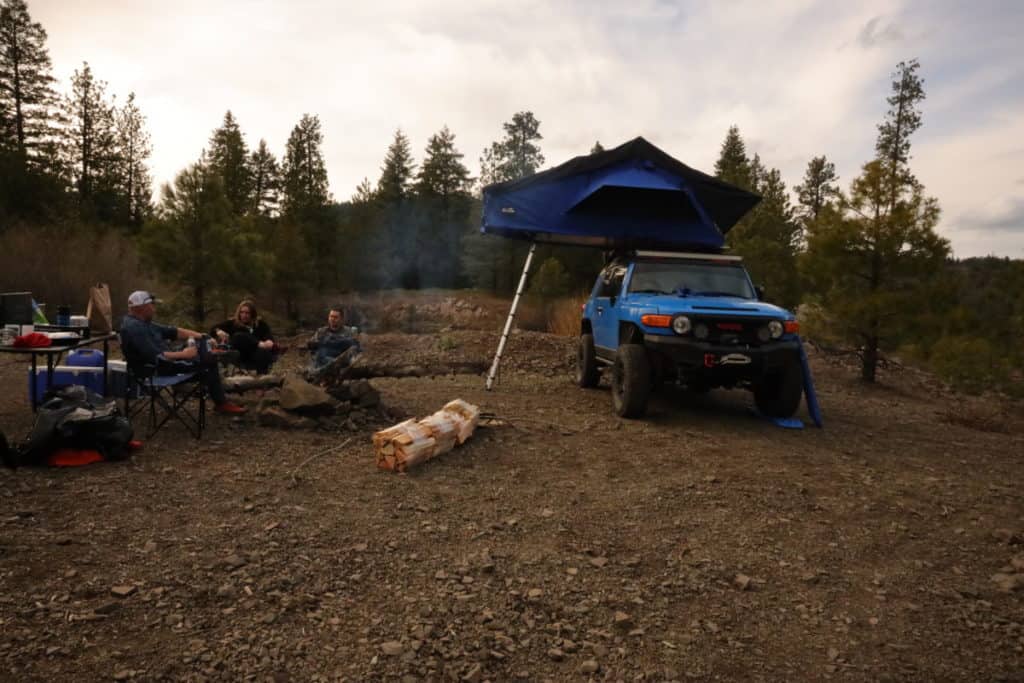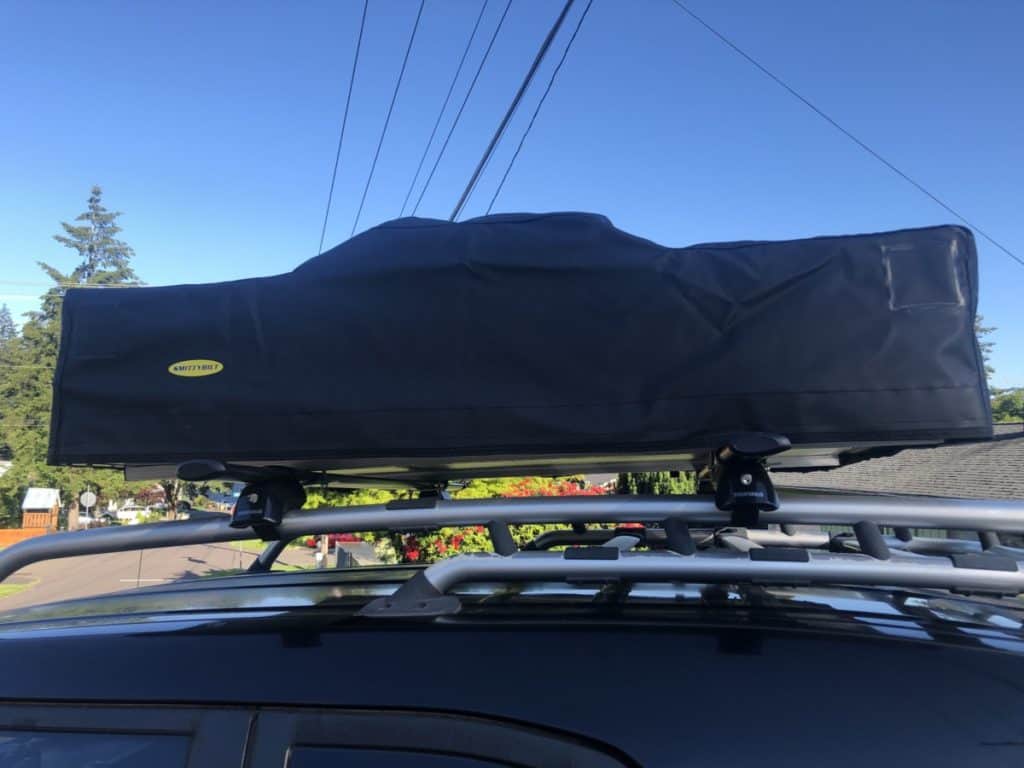
When I first bought my roof top tent, all of my friends and family hardly even knew what it was. They didn’t understand the point of it, the purpose it served, or how it worked.
I would repeatedly hear the same questions from everyone that wasn’t familiar with the idea and I would give a simple answer each time. The most common question I would hear is “so how does it work and what is the point of it?”
Roof top tents work by simply mounting it to a roof rack or crossbar system that can handle the weight of the tent. They can be mounted to your vehicle’s roof, truck canopy or bed, and even a trailer.
While that is absolutely the short answer, there is a lot more to consider when asking how roof top tents (RTTs) work. So we will go a bit more in depth and talk about the mounting system, weight limits, and how RTTs work in a general sense as well.
What are roof top tents made of?
The materials used to make a roof top tent would be 260-gram poly-cotton ripstop fabric, an aluminum frame, aluminum ladder, and a base with aluminum that may have added insulation.
Generally speaking, this is what you will find in most RTTs. When looking at four-season RTTs, the canvas will be thicker, at around 360-grams for better insulation. The fabric on the tents is completely waterproof and you will find mattresses to be anywhere from 2 – 3.5 inches thick. Some are made of foam and others will be high-density foam, which is more comfortable.
Hardshell RTTs can be made of fiberglass, all-aluminum and steel, or a hybrid of the two. These are far more durable and the starting cost for these models is around $3,000. The Hardshells typically offer more comfort, insulation, and longevity as well.
The base of the tent will often be made from a thin sandwich layer of aluminum. In more durable models, you will find an aluminum honeycomb design which handles more weight and has better durability. The more expensive models will usually have an insulated base as well.
The ladders in RTTs are made from aluminum and can be a sliding or telescoping design. Sliding ladders have a track they slide back and forth on and are secured by a pin on each track. This type of ladder can be a nuisance since dirt and mud will get in the tracks, causing it to stick which makes it harder to slide up and down.
The other ladder type is telescoping which is the more preferred design by far. The telescoping ladder is much more compact, doesn’t stick, and is easier to set up. This ladder type is becoming the standard on RTTs since it is so superior. The weight limit for most ladders on a RTT is roughly 250-400 pounds.
How do you mount a roof top tent?


You mount a roof top tent to a roof rack or crossbar system by using a set of four brackets. Each bracket has a set of two bolts and nuts for each corner of the tent to be secured with. The mounting brackets consist of a sliding bracket, a bolt, a washer, and a metal mounting plate.
For a visual aid, you can see the brackets’ components and how it is mounted to my roof rack in the pictures above.
Once the tent is placed on your roof rack, the process is actually very simple. In short, you simply need to center your RTT on the rack from front to back and side to side.
After that, you use a ratcheting wrench to tighten each of the bolts and nuts until you see a slight bend in the metal mounting plate. You will repeat this process for all four mounting points until complete!
You can also find quick release mounting brackets like the ones from Frontrunner. This mounting system requires no tools, just put the tent into place and clamp it secure.
This is the condensed and very brief version of my explanation for mounting a RTT. If you want a more helpful step by step mounting guide, click here to be directed to another one of my articles. It has many more helpful pictures to better explain the process too!
How do you use a roof top tent?
Once a roof top tent is mounted to your vehicle, all you have to do is open the tent and you’re ready to camp! You can use a RTT as many places as your vehicle can take you. Most campgrounds and even some RV sites will allow you to use a RTT, but they are especially useful for dispersed camping and secluded offroad trails.
The process to open a RTT varies depending on the style, whether it is softshell or hardshell. For softshell tents you will first take the cover off, and then use the ladder to pull it open. A hardshell is more streamlined since almost all of them utilize gas struts for an effortless pop-up process. Once you undo the latches and the shell pops open, you simply set up your ladder and you’re ready to camp!
The one thing you need to do before opening your RTT is making sure your parked on a reasonably flat surface. You can use traction boards, wood, or rocks to help level your vehicle. By no means does it need to be perfect, but it needs to be reasonable so you’re not rolling around in the tent.
What kind of roof rack do you need for a roof top tent?
The most important thing that a roof rack must have are crossbars that run from side to side on your vehicle. This allows the mounting tracks on the bottom of the RTT to be properly aligned and therefore secured to the roof rack.
As you can see in my picture below, the tent’s mounting tracks sit perpendicular to the crossbars, which are black.

I went with the Yakima Corebars because they are rated for 165 pounds of dynamic weight. The dynamic weight limit (DWL) is the amount of weight the rack can handle when the vehicle is in motion. Our Smittybilt Overlander is roughly 130 pounds or so, which is way lighter than the DWL of our Corebars.
As long as your roof rack and vehicles roof are rated to handle a DWL that is equal to or high than the weight of your RTT, you’re in the clear!
Permanent roof racks are also very common, like the Frontrunner or Gobistealth rack. These both have many crossbars built into the rack already and can handle more weight than a crossbar system like Yakima’s or Thule.
This just barely scratches the surface in this topic so if you would like to see more examples and get recommendations for the best roof racks for RTTs, you can head over to my article on How to Choose a Roof Rack!
How much weight can a roof top tent hold?
The general rule of thumb for the weight limit of a roof top tent is 200 pounds per person of the sleeping capacity of the tent. For example, if your RTT has a sleeping capacity of three people, the weight limit would then be 600 pounds in total.
However there is some slight variation to this metric and when you look at the specs of a tent, it will sometimes detail the weight limit. The weight limit can be higher for some tents if they use an aluminum honeycomb design, which increases strength and durability.
An example of this would be Roofnest, all of their tents have a weight limit of 650 pounds, no matter if it sleeps 2, 3, or 4 people!
Related topics
The concept of RTTs has been around for a long time in areas of the world like Africa, South America, and Australia. It hasn’t been until more recent years that America has adopted this trend of comfortable camping as well.
How RTTs work is actually quite simple. The most difficult task of owning one is storing and mounting the bulky and heavy item. As RTTs continue to grow in popularity, better technology for mounting has been developed to save users even more time and less headaches.
If you’re a beginner and looking to learn a little bit more about this fun and practical toy, I have specially selected a couple of articles I have written that is most closely related to this topic. Feel free to read more or even check out our Youtube channel which you can access through the menu of our homepage.
